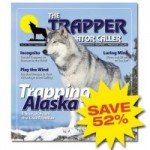
Trapper & Predator Caller fur market expert Serge Lariviére
Some experts say the steep drop in average prices
from 2013 to 2014 was unprecedented
By Serge Lariviére
This is an excerpt from Trapper & Predator Caller‘s August 2014 Fur Market Report.
The perfect storm has now hit in full force, and the reduced fur prices we had seen earlier this year simply continue to go down even more. The late May auction held in Toronto by North American Fur Auctions reported an overall drop of 70 percent compared to the previous year. I was told this drop was the biggest in fur prices in a year in more than 30 years.
In the auction world, the drop was compared to that of the late 1980s and early 1990s. Others say a drop in prices this steep and this fast has never happened before and that we’ve never seen a combination of the prices climbing so high one year and dropping back so steeply the next. In fact, just selling some species was a challenge — at any price — and many of the furs sent to the late auctions remained unsold. There is no denying it now: the fur bubble has burst.
At the risk of being redundant, we all know where it started. Last year’s weather was unseasonably warm in China and Russia — exactly the opposite of the brutal winter weather we had here in North America. Since China is where most of our wild fur goes these days, this warm weather, combined with a short selling season and the high prices of garments caused by last year’s record prices, made for some tough selling throughout China. When fur stores fail to sell their inventory, retailers do not need to order new skins, and fur brokers have no cash in hand to buy the new skins that are produced. Many of the large-scale brokers that come to the sales to buy skins for manufacturers and retailers in China attended out of habit or with very small orders, some even stating that their usual customers ran out of money.
The reality is that when the retailer’s money is tied up in inventory, there is no money left to buy new skins. Moreover, when prices start going on a downward trend, it encourages waiting, as everyone figures that waiting a little more can enable them to get fur even cheaper. Many buyers with no urgent orders simply waited to see what would happen next.
The perfect storm was compounded by 2013’s record high prices. Inventory in hand was much pricier than normal. Another tough factor was the huge numbers of ranch mink hitting the market. This year’s production was estimated at 75 to 80 million skins. In comparison, ranch mink production in 2013 was estimated at 62 to 63 million skins. In this difficult market, an additional 12 to 18 million ranch mink skins hit the market.
This storm hit all auction houses in a similar fashion, with price drops on most species and a lot of unsold fur. Surprisingly, some species maintained good prices — muskrats especially. Overall, though, almost all items took a deep plunge.
Serge Lariviére, a Trapper & Predator Caller field editor, is a wildlife biologist in Quebec, Canada. You can e-mail him at trappeurserge@hotmail.com.
This is a preview of the August 2014 Fur Market Report. The full column is available in the August issue of Trapper & Predator Caller.
You can pick up a copy of the digital issue on www.ShopDeerHunting.com.
Subscribe to Trapper & Predator Caller Magazine
 Trapper & Predator Caller is the best trapping and predator hunting magazine. Why aren’t you a subscriber? Sign up today and receive furbearer news, trapping techniques, fur market reports and more right to your mailbox.
Trapper & Predator Caller is the best trapping and predator hunting magazine. Why aren’t you a subscriber? Sign up today and receive furbearer news, trapping techniques, fur market reports and more right to your mailbox.

